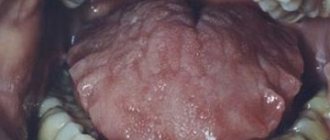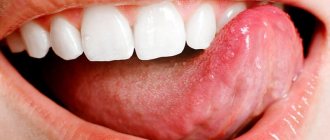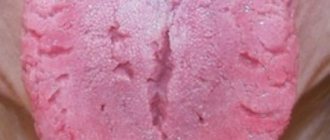White coating on the tongue is a layer of organic substances, bacteria and dead cells, accompanied by swelling of the papillae of the tongue, which can indicate various diseases of the lungs, kidneys or gastrointestinal tract: gastritis, stomach ulcers, enterocolitis.
Plaque on the tongue is a common phenomenon, which many consider simply a feature of their body. And they often forget that you need to brush not only your teeth, but also your tongue. However, many do not know that the appearance of plaque is a symptom usually associated with digestive problems. And it is necessary not only to regularly clean off plaque, but to find the root of the problem and select the appropriate treatment.
If you do not undergo treatment and do not carry out oral care procedures daily, the tongue looks as if it is burned, and bad breath appears. The correct treatment is prescribed by the doctor after testing, and we will try to figure out how to remove plaque from the tongue.
Why do you need to clean your tongue?
When considering the question of how to get rid of white coating on the tongue, you need to start with the basics. The tongue of a healthy person should have a pink color, the surface should be elastic and slightly moisturized. At the same time, a light white coating is not considered a pathology, and this nuisance can be easily eliminated by ordinary cleaning. It's another matter when a strong coating appears. This may indicate the presence of a serious disease in the body.
Cleaning your tongue from plaque at home helps solve the following problems:
- Reduces the concentration of pathogenic bacteria in the oral cavity;
- Prevents the appearance of tartar and caries;
- Freshens breath;
- Improves the functioning of taste buds.
How to choose
If the product is not fresh or has been frozen and defrosted several times, then you are unlikely to be able to prepare a tasty and appetizing dish, so it is better to take the advice of experienced chefs so as not to make a mistake in your choice:
- the color of the tongue should be bright pink or purple, a pale pink shade is obtained after defrosting, and gray when the product begins to deteriorate;
- the smell should not cause unpleasant sensations. If a foreign aroma is felt, it means that the product was soaked with potassium permanganate or other additives;
- A clear liquid and drops of bright red blood should appear on a cut of a fresh product.
There is an easier way to determine the freshness of beef tongue - press the tongue with your finger. If the shape is restored within 10-15 seconds, then it is a fresh product. Otherwise, one should doubt its quality.
The benefits of the finished dish will depend on the amount of time spent on its preparation. The longer the tongue is cooked, the less nutrients remain.
The age of the animal can be determined by the weight and color of the offal: the tongue of a young calf weighs up to 1 kg, and an adult animal weighs 2-2.5 kg. A bright pink color indicates that the animal was still young, and a dark red color with a purple tint indicates that the animal is quite old.
The supermarket usually sells frozen food. To prevent it from losing its beneficial properties, defrosting is done gradually, avoiding temperature changes. The bottom shelf of the refrigerator or a bowl of cold water is suitable for these purposes.
Now you can start cleaning the offal.
Reasons for appearance
Why does white plaque appear? The main reason lies in food debris that gets stuck between the lingual papillae. As a result, a favorable environment is created for the proliferation of bacteria. Most of these microorganisms die, but do not disappear without a trace. When in contact with saliva and epithelial particles, they stick to the tongue, forming a plaque. In this case, this plaque is partially removed by salivation. The film usually remains in hard-to-reach places, for example, at the root of the tongue. If it is not cleaned in time, it begins to spread to other areas, gradually covering the entire tongue. Considering that these are the remains of bacteria, the likelihood of developing dental diseases increases sharply.
Beneficial features
Beef tongue takes a long time to cook, in addition, it must be thoroughly cleaned - first to remove external contaminants and remaining films, and then remove the skin from it. Is this product worth the effort? Still, yes, it’s worth it.
- It has an unusually high zinc content. And iodine, phosphorus and calcium help the functioning of the endocrine system.
- Suitable for feeding people with diabetes.
- Helps accelerate tissue regeneration, which is necessary for people who have undergone surgery.
- Useful for patients with gastritis and peptic ulcers.
- In case of anemia, the tongue improves blood composition.
Signs of plaque on the tongue
Tongue plaque can be a physiological phenomenon or a side symptom of a serious disease. In the first case, you can remove the white coating on the tongue yourself, without going to the dentist. In the second, you will need the help of a qualified specialist. A white tongue can directly indicate a fungal infection or dehydration of the body
Physiological signs:
- Uniform white or yellowish color;
- A thin layer through which the lingual papillae are clearly visible;
- No unpleasant odor, pain, or other symptoms;
- Appears for certain reasons, for example, due to thirst;
- Easy to clean with a toothbrush.
Pathological signs:
- Dense consistency, difficult to remove;
- Unhealthy color: yellow, brown, gray;
- Covers the entire surface of the tongue;
- Accompanied by an unpleasant odor;
- A sour or bitter taste appears in the mouth.
How to prepare offal for cooking?
The meat will turn out tender, juicy and aromatic only if it is properly pre-processed. Regardless of whether you plan to boil pork tongue or beef tongue, you need to take into account the following points:
- If you clean the component before cooking, there is a risk of ruining it beyond repair. Firstly, cleaning will take a lot of time, because... the skin will come off reluctantly. Secondly, a significant amount of the edible part will definitely be removed along with it. Finally, such a protective film retains moisture, making the dish juicy.
- But all excess meat and fat should be cut off. Their presence increases the calorie content of the broth, especially if it is pork tongue. Because of this, the dish turns out to be too rich and even greasy.
How to remove plaque from the tongue at home
How and with what to clean the tongue of an adult? There are several ways to quickly deal with this problem. Let's look at each of them in more detail.
Scrapers
These are special loop-shaped devices made of hygienic plastic. Scrapers effectively remove plaque without causing discomfort or gag reflexes. The tool must be moved from the base of the tongue to the tip until the film disappears. After this, the mouth can be rinsed with an antibacterial solution.
Toothbrushes
Most models have special pads on the back surface or removable attachments for removing plaque. Hygienic procedures are carried out according to the scheme discussed above. To enhance the effect, you can apply a small amount of toothpaste to the surface of the nozzle.
Irrigators
These are modern devices for comprehensive oral care. The essence of the irrigator’s work is the directed supply of a stream of water, which gently but effectively removes food debris and plaque on tooth enamel and tongue. Irrigators work very delicately, the possibility of damage to the mucous membrane is completely eliminated. In this case, to enhance the effect, water can be replaced with a medicinal liquid with an antibacterial or anti-inflammatory effect.
Spoons
Sold in pharmacies, in appearance they resemble a small spatula with rounded edges. Thanks to this form, the possibility of injuring the tongue is eliminated.
Special spoon attachments are available for irrigators. For example, a replaceable nozzle TS-100E. This instrument is recommended by dentists for daily hygiene procedures; it effectively removes plaque and helps freshen breath.
Rinse
To clean the tongue, decoctions based on medicinal herbs and plants are used:
- Oak bark;
- Propolis;
- Calendula;
- Sage.
However, it is important to understand that it will not be possible to remove plaque with the help of decoctions alone. This method cannot replace mechanical cleaning and is used rather for preventive purposes.
Step-by-step instructions on how to boil and peel pork tongue:
Prepare pork tongue (weighing about 300 g), carrots (0.5 pcs.), onions (1 pc.), bay leaf (1 pc.), black peppercorns (6 pcs.), cloves (3 pcs.), salt (0.75 tsp), water.
Wash the pork tongue thoroughly, clean the remaining dirt with a sharp knife, scrape off the coarse coating, and cut off the larynx.
We clean the carrots and onions. Cut the carrots into large pieces, cut the onion into 6-8 parts, without cutting all the way from the tail side. You need to stick a clove into the onion.
Place the prepared tongue in a small saucepan and fill it with cold boiled water so that it covers the tongue by 1 cm.
Add onions, carrots, bay leaves, and black peppercorns to the tongue. Place on the stove, bring to a boil over high heat under the lid, then reduce the heat to low and cook the tongue. After 30 minutes, salt the water and remove the bay leaf. We continue to cook the tongue.
After 1.5 hours, the pork tongue is ready! If the tongue is larger, the cooking time increases.
We take it out, check its readiness with a fork - the flowing juice should be clear, and the tongue itself should be soft. We clean it under cold running water - the skin comes off easily! You need to clean your tongue while it’s hot, immediately after cooking, and under running cold water! This is an important point at which the skin will be removed easily and almost effortlessly!
If you cannot clean the entire tongue under running water, use a knife to clean it on a cutting board, lightly scraping the skin.
We use the finished peeled tongue for its intended purpose - we serve it as a hot or cold meat appetizer, we use it to prepare salads, sandwiches and other dishes!
Fresh pork tongue has a uniform color when cut. The larger the tongue, the longer it will take to cook! In the same way, you can boil and peel beef and veal tongue.
Pork tongue is truly a delicacy. It is served as an independent cold appetizer, and is also included in various salads. If this product is prepared correctly, it will be soft, tender and have an incredible taste.
In the process of preparing such a dish, the question arises of how to properly clean the pork tongue, because it is necessary to do this not only quickly, but also in such a way that after removing the film, as much pulp as possible remains and it retains its aesthetic appearance. It should look very neat if the pork tongue is served as a separate dish.
How to properly clean your tongue with a toothbrush
How to properly clean plaque from your tongue using a toothbrush? To do this, it is enough to follow the following rules:
- Cleaning is performed after basic hygiene procedures: brushing the teeth and rinsing the mouth;
- Plaque is removed with progressive movements: the brush goes in one direction, first from the root to the tip of the tongue;
- Then the brush moves in the transverse direction, and then in the return direction: from tip to root;
- 4-6 movements are made in each direction;
- After this, the inner surface of the cheeks is carefully processed,
- At the final stage, rinse with an antibacterial solution.
Nutritionist's opinion
Today we looked at how to properly clean beef tongue. This will allow many housewives to decide what to serve as a snack. It costs less than sausage, and looks even more interesting. But despite the excellent taste of the delicacy and low fat content, it is not recommended to eat it too often and in large quantities.
The high content of a number of components creates an increased load on the kidneys. This restriction is especially important for older people.
How to properly clean your tongue with an irrigator
Cleaning the tongue from plaque with an irrigator is carried out in compliance with the following rules:
- The procedure begins with a slight pressure, which gradually intensifies;
- The angle of impact of the jet should vary between 60-90 degrees;
- Duration of cleaning – 2-3 minutes;
- First, the general surface of the tongue is processed, then hard-to-reach areas;
- The procedure must be performed daily, at least once.
It is important to understand that the use of irrigators does not mean giving up mechanical brushing of teeth. Therapeutic liquids for the device are used strictly as prescribed by the doctor.
Useful tips
To avoid problems when cleaning your tongue and preparing it, you need to follow a few simple rules:
- the knife must be well sharpened and designed for cutting meat;
- To get a clear broth for aspic, you need to not miss the moment when the broth starts to boil. During the cooking process, remove scale in time;
- immerse the finished tongue in cold water before starting to peel off the skin;
- if the skin from the tongue is difficult to peel off, you need to make transverse cuts, trying to cut through only the skin;
- add a minimum amount of spices so that they do not “drown out” the taste of the meat;
- add salt only at the end of cooking;
- You can easily check if it is ready by piercing your tongue with the tip of a knife. If a cloudy liquid comes out, the meat is not ready yet. In this case, you should return the product to the pan and cook for another half hour;
Properly cleaned and cooked beef tongue will bring pleasure to everyone who will participate in the meal, and will give your loved ones vigor and strength.
Prevention of plaque formation on the tongue
- Brush your teeth and tongue at least twice a day;
- Include fermented milk products in your daily diet, eat more vegetables and fruits;
- Reduce the amount of spices, spicy and smoked foods you consume;
- Quit smoking and alcoholic beverages;
- Regularly undergo preventive examinations at the dentist;
- Do not cause diseases of the gastrointestinal tract.
Do I need to clean my tongue of plaque? Of course, even if we are talking about the physiological characteristics of the body. The film that appears on the tongue is traces of the vital activity of pathogenic bacteria, so if the plaque is left unattended, a favorable environment is created for the development of infectious diseases of the oral cavity.
Thanks to irrigators and other devices, taking care of your oral cavity is not at all difficult, and by spending just a few minutes a day, you can maintain a snow-white smile for many years.
Author of the article
Preparatory stage
How to cook pork tongues and peel them?
Before cooking, the product must be washed and excess fat removed, because dishes made from it are already high in calories. Veins and other inedible parts should also be removed.
You should not peel the skin off the product in its raw form, because it is difficult to do and you may lose a certain amount of meat.
To get a truly delicious dish, you need to know:
- a fresh tongue is bright red;
- if the product is fresh, then it smells pleasant, a little sweet;
- Before cooking, it is necessary to soak the product for several hours.
Unacceptable actions
If there is a burning sensation in the mouth, if there is damage to the mucous membrane of the pharynx, you should not do the following:
- eat hot or too cold food;
- drink sour drinks and fruits;
- include aggressive foods in the diet (sour, spicy, salty foods);
- chew chewing gum;
- brush your teeth with a paste that contains sodium lauryl sulfate;
- cauterize with alcohol compounds, brilliant green.
At the time of treatment, you should not visit crowded places (or wear a respiratory mask) or rooms with chemical dust.
During treatment, a protective regime should be observed to prevent diseases that weaken the general immune system.
Therapy tactics
Treatment of burning sensation in the tongue area begins with sanitation of the oral cavity (treatment of caries, removal of tartar, hygienic cleaning of teeth, including periodontal pockets).
If you have dentures, braces and other orthodontic structures, they are checked and, if necessary, cleaned or replaced.
For stomatitis, gingivitis and other diseases of the mucous membrane, treatment is carried out. Treatment for glossalgia is prescribed only against the background of a completely healthy mouth.
Medication correction
Treatment is prescribed after the true cause of the burning sensation has been established. When the root cause is eliminated, glossitis usually goes away on its own.
The mandatory groups of drugs for the treatment of burning and other unpleasant sensations include:
- rinsing the mouth with antiseptics (Miramistin, Furacilin, Chlorhexidine aqueous);
- the use of ointments and solutions with Lidocaine, Novocaine (baby gels are suitable for teething).
If glossalgia is of a fungal nature, local medications based on active ingredients such as Clotrimazole and Nystatin are prescribed.
If the cause is bacterial, then Metrogil-denta and Metrogil gel are prescribed. If the causative agent of the burning sensation is viral agents, then it is advisable to prescribe Acyclovir, Florenal ointment, Oxolinic ointment.
Unpleasant symptoms are perfectly eliminated by means of systemic action: sea buckthorn oil, Actovegin gel, solutions of oils A or E. If respiratory disorders are noted against the background of glossalgia, it is recommended to take Hydrocortisone, Prednisolone.
All prescriptions are made by a doctor after a thorough diagnosis of the disease. In childhood, in the later stages of the disease, hospitalization may be necessary. Additionally, drugs from the group of corticosteroids may be needed.
Alternative medicine
With localized glossitis, without deterioration in general well-being, you can limit yourself to traditional methods of therapy at home.
In case of herpetic infection or the fungal nature of the disease, it is unacceptable to use alternative medicine recipes as monotherapy.
The main means for maintaining oral health include the following:
- Oak decoction. Decoction of oak bark (rinsing or internal use).
To prepare, grind 20 g of bark, place in a saucepan, add water and seal tightly with a lid. The container with the composition is boiled over a fire and infused. The finished broth is filtered and taken as a generous rinse several times a day. A fresh decoction should be prepared every day. To improve the therapeutic effect, the decoction should be warm. - Sage infusion. Sage is a powerful natural antiseptic.
Prepare the infusion as follows: place 20 grams of dry herbs in 200 ml of boiling water. The broth is infused for about 2-3 hours in a thermos or in a hermetically sealed pan, which can be wrapped in a terry towel and covered with pillows. Rinse the mouth with the prepared decoction several times a day. - Curd product. Cottage cheese is mixed with fat sour cream in a 1:1 ratio, wrapped in gauze and applied to the tongue for a long time. Sour cream softens mucous tissues, and cottage cheese acts on an absorbent principle.
- Herbal collection. To prepare the decoction, place yarrow, chamomile, sage, aloe, and calendula in equal proportions in a bowl of boiling water and leave for an hour.
After preparation, strain the mixture and rinse every 3 hours. The therapeutic effect is observed in the next 3 days. This decoction is a good addition to the main treatment. - Honey and chamomile. To prepare the product you will need a propolis tincture and a ready-made chamomile decoction. Add 15 drops of tincture to a warm herbal decoction (about 200 ml). Rinse your mouth with this mixture for 24 hours. Duration of treatment is 7-10 days. Not suitable for young children.
To achieve good therapeutic results, traditional medicine recipes should be taken adequately.
Thus, when serious diseases of internal organs or systems are manifested, as well as when dental conditions are registered, the use of chamomile decoction alone will not give the expected results. Treatment with traditional methods is often carried out only in combination with conservative therapy.
What can cause a metallic taste in the mouth and how to get rid of it.
This article contains material on the development and treatment of allergic stomatitis.
Follow the link https://www.vash-dentist.ru/lechenie/bolezni-polosti-rta/stomatit-bpr/lyugol.html and find out detailed instructions for using Lugol for stomatitis in a child.
Diagnostic measures
Diagnosis of pathology consists of a visual assessment of the oral cavity by the dentist. Additionally, you should visit an endocrinologist, neurologist or gastroenterologist. To clarify the general picture of the disease, the following tests should be performed:
- blood for detailed biochemical parameters;
- blood test for plasma glucose levels (for the possible development of diabetes mellitus);
- throat swab for laboratory testing;
- stool analysis for enterobiasis.
In case of a burdened clinical history, additional tests should be taken and examined by various specialists in the field to exclude exacerbation of other diseases of internal organs or systems.
Dangerous causes of blood taste in the mouth and ways to eliminate it.
Read here what can cause a white bump on the gum.
At this address you will find a complete list of human tongue diseases.
Predisposing factors
Itching and burning in the tongue area can occur for a number of reasons, so it is very important to conduct a whole range of studies to establish the true mechanisms of pathology formation.
General factors
Often, a burning sensation on the tongue is provoked by mechanical damage when the mucous tissues of the tongue are affected, leading to disruption of the capillary blood supply.
If the burning sensation from the tongue tends to generalize to the inside of the cheeks, palatine space and lips, then the development of stomalgia occurs. The disease occurs when mucous tissues are systematically traumatized by teeth with chips, cracks or sharp edges, braces or incorrectly installed fillings.
In addition to injuries, burning sensation can be caused by the following factors:
- reduction of gastric secretion up to 75%;
- Iron-deficiency anemia;
- B12-deficiency anemia (lack of vitamin B leads to deterioration of nerve conduction);
- gastroduophageal reflux of any origin;
- diabetic disease;
- some mental illnesses (innervation of nerve roots and processes increases during excitement);
- carrying out antihypertensive therapy (with long-term treatment with Capoten, Monopril, a short-term burning sensation may occur);
- active phase of the menstrual cycle in women;
- menopause.
Often, a burning sensation in the area of the tongue and sublingual cavity is recorded against the background of viral hepatitis of any group, pulmonary tuberculosis, cholecystitis.
When the hypothalamus is disturbed, damage to the autonomic nervous system occurs, which leads to a deterioration in blood microcirculation and the secretion of various glands, including salivary glands.
Therefore, with diabetes and other endocrinological diseases, dry mouth and burning sensation on the tongue are noted . Stress, overwork and emotional instability can provoke the occurrence of such a symptom.
Pathological causes
In dentistry, there are several main factors that cause dry mouth, soreness, burning of the tongue and discomfort in the oral cavity:
- Xerotomia. The symptom complex of xerotomy is expressed not only by dryness and burning in the tongue, but also by a disturbance in the secretion of the salivary glands.
On examination, cracks ranging from barely noticeable to pronounced deep are noted on the surface of the tongue. The burning sensation intensifies to the point of pain when the patient eats acidic foods, fresh fruits, carbonated or sour drinks. The etiology of xerotomia is often caused by dehydration due to intoxication, Sjögren's disease. - Candidiasis. Fungal infection of the oral cavity is always accompanied by unpleasant sensations in the form of itching, burning, pain in the areas of fungal rashes.
Candida fungus exists in all people, but under certain factors it turns into a pathogenic agent, causing diseases.Clinically, with candidiasis, the tongue is coated with a white, often dry coating, and the tongue area itself turns a rich bloody color. Along with itching and burning, patients experience severe pain on the tip of the tongue.
- Allergic reactions. Allergies and inflammation are often the body's reaction to foreign bodies in the oral cavity.
Thus, when installing braces, during prosthetics or osseointegration, as well as when wearing removable orthodontic structures, irritation may occur. Despite the hypoallergenic nature of modern materials, the likelihood of allergies, rejection and other unpleasant consequences of prosthetics is quite likely. - Deposits on tooth enamel. Insufficient care or lack of oral hygiene leads to the formation of stones on the inner surface of the tooth.
Hard plaque contains huge colonies of pathogenic microorganisms that release toxic components.Microbes provoke the development of inflammatory foci in the oral cavity, leading to chronic glossalgia. The condition is easily eliminated by hygienic teeth cleaning at the dentist.
- Epithelial leukoplakia. When the mechanisms of desquamation of epithelial structures at the cellular level are disrupted, as well as disruption of regenerative processes, it leads to the formation of white plaques on the cheeks, on the surface of the palate and tongue.
Often the course of the disease is latent with temporary episodes of exacerbation. Leukoplakia occurs more often in smokers, becoming a sign of a precancerous condition. - Herpetic rashes. Herpes is an infectious disease of a viral nature.
Once an episode occurs, it almost always leads to chronicity of the pathological process. The appearance of blisters on the mucous membranes of the throat indicates an exacerbation of the disease and requires immediate use of antiviral drugs. As the patient recovers, the blisters transform into small erosive lesions.
Almost all diseases of the oral cavity of any origin can cause glossalgia. This is due to the huge number of nerve roots and receptors in the tongue and sublingual cavity, including multiple capillary weaves.











